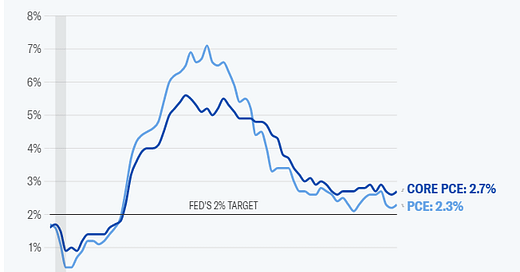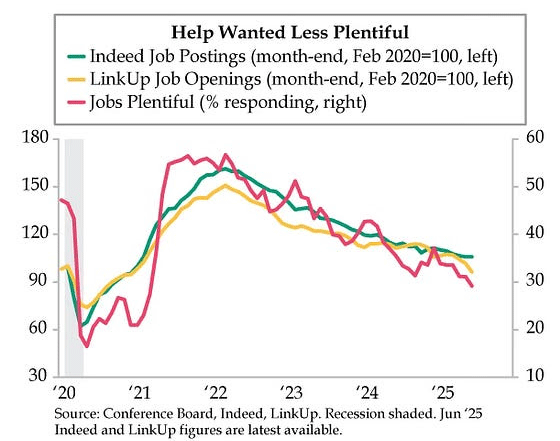Stocks peak about every 36 years, most recently in 1929, 1965, and 2000. This 36-year cycle can be traced all the way back to the earliest eras in recorded human history, back to Pythagoras and Plato and the Axial Age around 600BC. After each peak comes a period of decline (punctuated by bear market rallies) that typically lasts 16 years or so. Then, with the excesses of the prior bull period wrung out and investors most depressed, the next 20-year run to the next market top can begin. We're in that Golden Age now – take advantage of it!
Howdy, Bull-Riders:
This morning's May Personal Consumption Expenditures (PCE) index increased 2.3% year-over-year, a slight uptick from April's 2.2%. The month-over-month increase from April was 0.1%. The Fed's favorite inflation indicator, the core PCE that excludes changes in food and energy prices, was up 2.7% year-over-year. Both the April increase and the consensus expectation for May were 2.6%. Month-over-month, the core PCE rose 0.2%, also a tenth above both the April increase and the consensus expectation for May.
h/t Yahoo Finance
Fed Chairman Powell just testified that the central bank is “well-positioned to wait” before moving interest rates, and I don't think there's anything in this report to change that. Wall Street focused on other data showing signs of slowing economic growth. Real personal spending decreased 0.3% in May after increasing 0.1% in April. Personal income fell 0.4% in May, well below the 0.7% increase seen in April and the 0.3% increase economists had expected. But Powell needs to see a direct impact on the labor markets before he makes a move.
Last September 16, CareerBuilder and Monster merged. The CEO said: “The combination of CareerBuilder and Monster brings together two strong, trusted, complementary brands to create a job board with greater scale and reach.”
On Tuesday, a short nine months later, the merged company filed for Chapter 11 bankruptcy. What happened? This:
h/t @DiMartinoBooth
The latest Conference Board Consumer Confidence report said that households’ “appraisal of current job availability weakened for the sixth consecutive month,” and consumers “were more pessimistic about business conditions and job availability over the next six months.”
Weak help wanted ads could be an early warning indicator, but as I've said, I am watching what the Fed watches - weekly new unemployment claims - to see if there is real employment weakness. If and when that number goes over 250,000 for a few weeks in a row, the pressure on the Fed to cut rates even though inflation is above their 2% goal will be intense. Today it was 236,000, a decrease of 10,000 from last week's 246,000. So, we're flirting with 250,000, but not there.
Continuing claims did go up from 1.937 million last week to 1.974 million, the highest level since November 2021. An increase in continuing claims is a sign that those out of work are taking longer to find new jobs, but that's not the main focus of the Fed.
Even so, according to the CME FedWatch Tool, after the employment claims data, markets are now pricing in a 27% chance the Fed cuts interest rates at its July 30 meeting, up from a 12.5% chance last week, Odds of a cut by the end of September surged from 64% to 92%.
I still think Chairman Powell needs to see worse labor numbers or substantially lower inflation numbers before he cuts interest rates. And remember that there is a “surprisingly” strong June quarter GDP number coming on the morning of July 30 before the stock market opens.
Market Outlook
The S&P 500 added 2.7% since last Wednesday and hit a new all-time high today for the first time since February. The Index is up 4.4% year-to-date. The Nasdaq Composite gained 3.2% to a new all-time high today and is also up 4.4% for the year. The SPDR S&P Biotech Exchange-Traded Fund (XBI) climbed 1.2% since the last issue. But it is still down 7.1% year-to-date. The small-cap Russell 2000 gained 2.8% and is down 2.6% in 2025.
The fractal dimension again is hinting that the consolidation may be over, and a new, roughly three-month-long, uptrend could start with indexes near all-time highs. One big up week or two or three smaller up weeks would do it.
Below The Paywall This Week
* * Tennis fans can access live scores
* * right-sizing the workforce
* * have sold over two million pairs
* * crushed the quarter and raised guidance
* * Fuggedaboudit
* * develop operating systems for many more regulated industries
* * new institutional payments initiative
* * thinks big!
* * a record high yesterday
* * ***we***have***a***winner***!
* * more precise, safe, and effective treatments for cancers
* * the narrow Strait of Hormuz
* * a low-cost long-term supply
* * a big winner when ______ prices take off
* * The fractal dimension shows a steady march towards full consolidation
* * the cheapest and easiest way to buy bitcoin
Coming Events for Free Subscribers
All times below are EDT.
Monday, June 30
Business Employment Dynamics - 10:00am – More hard truths about real payroll growth before the election
Friday, July 4
Markets Closed
Happy 249th, America!
Golden Age Portfolio Update
This was a very good week for the portfolio as it jumped 2.4%. We're now up 21.1% in 2025 and 117.2% since inception, with much more to come. Are you making money? Let's dig in...
* * * * * * * * * * * * * * * * * * * * * * * * * * * * * * * * * * * * * * * * * * * * * * * * * * * * * * *
Warren Buffett’s First Interview
* * * * * * * * * * * * * * * * * * * * * * * * * * * * * * * * * * * * * * * * * * * * * * * * * * * * * * *
“On June 11, 1776, the Continental Congress nominated a drafting committee of five men to compose a Declaration of Independence. The committee consisted of one southerner – Thomas Jefferson of Virginia – two New Englanders – John Adams of Massachusetts and Roger Sherman of Connecticut – and two from the Middle Colonies – Robert R. Livingston of New York and Benjamin Franklin of Pennsylvania. On July 1, 1776, Congress reconvened. The following day, the Lee Resolution for independence was adopted by 12 of 13 colonies, with New York not voting. Immediately afterward, the Congress began deliberating the Declaration. With minor changes by Adams and Franklin, Congressional discussions produced some alterations and deletions. But the basic document remained Jefferson's. The process of revision continued through all of July 3rd and into the late morning of July 4th, when the Declaration was officially adopted.”
h/t @DiMartinoBooth
* * * * * * * * * * * * * * * * * * * * * * * * * * * * * * * * * * * * * * * * * * * * * * * * * * * * * * *
Your Why Everything Feels Like It's Breaking—and Why That's the Point Editor,
Paid subscriber or not, if you would click the ♥ symbol below it would really help me get the word out.








